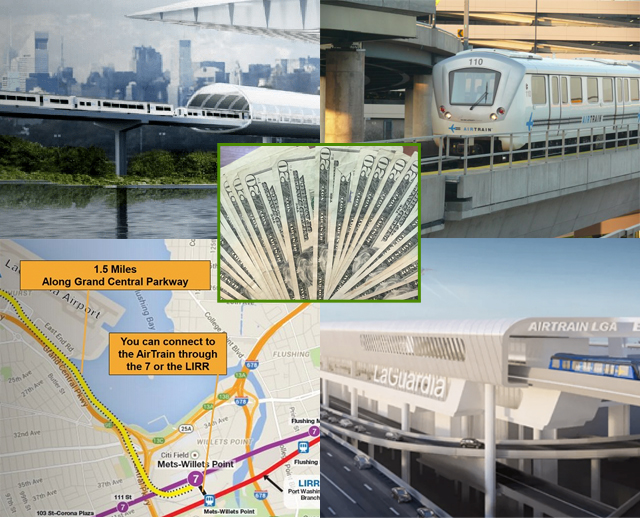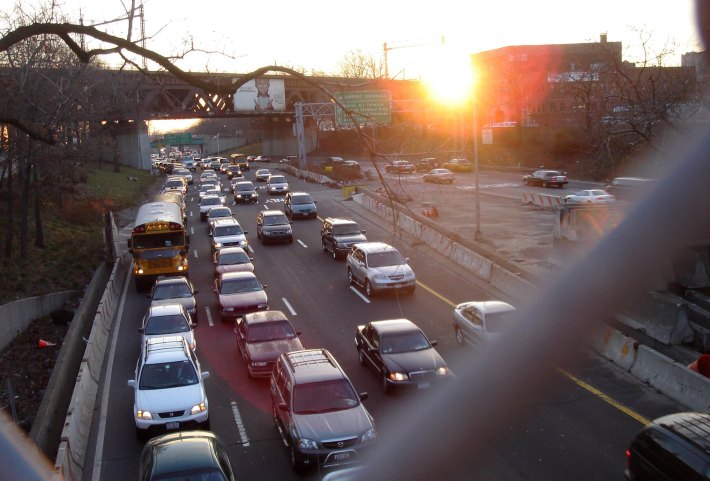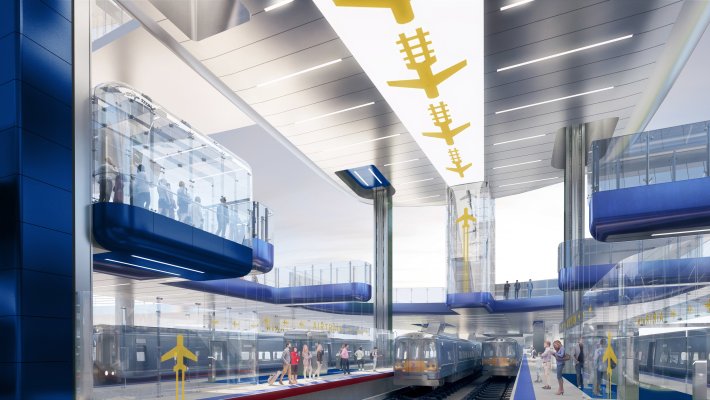LaGuardia AirTrain Documents Raise Questions About Parking, Development
12:01 AM EDT on April 21, 2021

Our AirTrain montage puts money at the center — because that’s what it it is about!
The Port Authority's plans for major development near the Willets Point terminus of its controversial AirTrain were so haphazardly studied that even the project's boosters at the Federal Aviation Administration said they deserved far more study.
According to documents uncovered by the environmental group Riverkeeper, the Port Authority discussed building "potential future passenger parking, and a consolidated rental car facility" at Willets Point, facilities which Riverkeeper notes could bring even more cars to the Grand Central Parkway, the main artery by the airport. Such big plans for an environmentally sensitive area — Willets Point is at the confluence 0f Flushing Creek and Flushing Bay — should have been, but unaccountably were not, considered as part of the AirTrain’s recently completed environmental impact statement, Riverkeeper contends.
The documents show that the FAA expressed concerns with the Port Authority's lack of transparency about its plans for development around the AirTrain terminal. The Port Authority's 2019 AirTrain environmental review did not calm FAA concerns about more parking, a possible rental-car facility, and further amenities; the federal agency said the plan “raises concerns ... and compels a thorough discussion of cumulative impacts from past and future actions, and inclusion of any connected actions" under federal environmental law.

Riverkeeper said that the FAA comment should have spurred more review, but actually had the opposite effect — merely putting the Port Authority on notice that it should keep its plans on the down-low.
“No matter its intent, the FAA's comment serves as a warning to the Port Authority to be careful with its wording and not to be forthcoming about how the AirTrain fits into its larger plans,” said Riverkeeper lead lawyer Mike Dulong. “This is telling because under federal environmental law, any connected past or future actions must be evaluated in a cumulative impacts analysis. Such an analysis would have to cover all of the past ‘major’ airport construction, and all of Port Authority's future connected plans.”
Whatever the FAA's qualms about future development around the AirTrain, it apparently didn't follow up on them. The FAA’s “Record of Decision” giving the Port Authority the final green light to construct the AirTrain is due any day — clearing the way for preliminary groundbreaking and electrical work in June.
As many have said, the "fix was in" for the AirTrain for a long time. The newly unearthed documents, however, have given important ammunition to the AirTrain's opponents. Citing them, critics have organized a pressure campaign asking U.S. Department of Transportation Secretary Pete Buttigieg to review the final environmental impact statement, issued last month. Other documents show that the Port Authority made exaggerated claims about the benefits of the AirTrain that affected how the rail and bus options that were initially proposed as alternatives to the project were evaluated and eliminated as part of the environmental review, critics say.
No lawsuits have been filed against the project, but comments on the draft EIS submitted by the Pace Environmental Litigation Clinic on behalf of Riverkeeper and Guardians of Flushing Bay last October suggest avenues for legal action.
The documents are only the latest wrinkle in the saga of the automated people mover — which would run for a mile and a half between the airport and Long Island Rail Road station at Willets Point along the Grand Central Parkway and the Flushing Bay promenade. A favorite project of Gov. Cuomo, the Port Authority's overlord, along with New Jersey Gov. Phil Murphy, the AirTrain early gained a reputation as a boondoggle. Critics have complained that its “backwards” route would send travelers further east from LaGuardia — and to a less-useful LIRR line — before they would double back toward the airport (or, during the reverse trip, Manhattan) and wouldn’t save travelers time. Transit analysts say that it adds nothing to the city’s transportation network. Others question the AirTrain’s service assumptions and construction disruptions. The area’s Congressional representative, Alexandria Ocasio-Cortez, objects to the project. Others have pointed out that a couple of car-free, dedicated busways between the MTA's 74th Street/Roosevelt Avenue station in Jackson Heights or to the 61st Street and LIRR stations in Woodside could ferry passengers to and from the airport much faster and cheaper.
The project also antagonizes environmentalists because of how it will affect the fragile environment around Flushing Bay, while it riles local homeowners worried about noise and property values. Still others — especially, newspaper editorial boards — dislike the project because of its ballooning price tag; it was supposed to cost $500 million, but its cost now has climbed to $2 billion and counting.
Meanwhile, others see it as the key element of the Port Authority's vision of a giant parking lot. In that sense, the AirTrain is not "transit" at all, but rather a way to push the parking needs of airport employees further into car-saturated Queens; indeed, one of the main criteria for the project's siting was to move all employee parking away from the airport. The Willets Point site was chosen, in part, because it was the best for that purpose.
The Port Authority insists, however, that the AirTrain is best, greenest transit option that could be built to supply the airport with a rail connection, and it and the AirTrain's backers — construction interests that are heavily represented among Cuomo's donors — have sold the project time and again as a jobs program.
The question of how many cars any additional development might attract to the area is a difficult one. The area around LaGuardia Airport is already a monumental car sewer. More than 90 percent of passengers and 60 percent of employees arrive to the airport by car. Currently, car-rental companies take passengers (inconveniently for them) via vans from the airport to sites scattered in nearby East Elmhurst and Astoria, so it's easy to see why airport planners might consider building a consolidated rental-car facility as a priority.
Proponents claim that the AirTrain will remove 4,000 cars daily from local roads and that it would serve 17 percent of airport passengers. But is that enough?
Transportation planner Robert Previdi thinks that both figures are piddling. He calls the 17 percent a “pathetically low” mode share compared to that enjoyed by other airports around the world. For example, 60 percent of passengers use trains to get to the airport in Oslo, Norway, and Gatwick Airport, which plays the same kind of subsidiary role to London's Heathrow as LaGuardia does to JFK and Newark, has a much more ambitious goal — 48 percent— than LaGuardia for increasing its rail mode share. The differences, he said, show that the Port Authority isn't really looking to build a viable rail connection to the airport as it is to pay for LaGuardia's $8-billion expansion "on the backs of the parking fees” and revenues from other amenities it might build on the airport or at the Willets Point AirTrain station.
“There seems to be no political objective to reduce the amount of traffic and parking,” Previdi said. “The percentage of people using the train at U.S. airports is too low when compared to European and Asian cities. ... We have a mass-transit system and don't encourage a better, more useful link to the airports.”
Previdi argues that, instead of an AirTrain, the LIRR itself should be extended along the same proposed route into the airport. A recent change in a federal rules, enabling the passenger facility fees collected by airports to be used for a greater variety of transit, would fund such a connection.

The documents raise even more questions about the Port Authority's parking plans. The Willets Point site for the AirTrain was chosen in part because it has room to host employee parking that must be removed from the tiny airport in order to maintain and reconfigure its runways, an FAA consultant told Streetsblog last year. But even the FAA had questions about the parking rationale, per the documents. According to its 2019 comments:
The need to relocate employee parking ... raises the question: what aeronautical uses are planned for the current employee parking areas? The requirement for providing off-airport employee parking is cited as project objective #5 and used to eliminate several alternatives which fail to provide it. If additional aeronautical needs would require use of the existing Parking Lot P-10 and/or other employee lots, the proposed development in those areas should be evaluated as part of this EIS to the extent practicable, or otherwise be included in a cumulative impacts analysis. The last sentence of that paragraph states, “A long-term solution for Airport employee parking is a major component of the LGA Redevelopment Program.” As such, any factors driving the need to relocate employee parking must be considered as part of this environmental review.
No such factors are cited in the EIS, Riverkeeper says. "I have never seen Port Authority's response to that demand, and I agree with the FAA that Port Authority's reasoning must be made public before the AirTrain is approved," Dulong said.
Moreover, per the EIS, the Port Authority will build only 500 parking spaces — for employees only — at Willets Point. But the FAA questioned that number, too: “Text refers to 1,500 parking spaces at LGA for employees, yet each alternative only considers accommodating a parking lot of 500 spaces off airport. Why is the discrepancy between the two so large? How was 500 determined to be the appropriate level of off airport parking?”
NEW: The @NYDailyNews
— Jessica Ramos (@jessicaramos) April 12, 2021
agrees with us! The Port Authority’s proposed LaGuardia #AirTrain will take over $2B to construct & doesn't even improve transportation for families #SeenIn13. It’s a vanity project and it must be stopped. https://t.co/E2QyZu0F14
The Port Authority, for its part, insists that it won’t build any more parking spaces for employees — or for passengers — or any rental-car facility at Willets Point. It declined to answer questions about why it needs to remove the employee parking from LGA and what it plans to do with that space.
“The plan to include parking within the operations and maintenance facility for AirTrain LGA has been fully disclosed in both the FAA’s Draft EIS and the Final EIS,” a spokesman said. “It would provide parking only for airport employees that would be relocated from on-airport, AirTrain employees, and replacement spaces for the Mets and the MTA. That means no rental-car facilities or airport-passenger parking.”
Moreover, the spokesman continued, “All of the parking will be housed within the footprint of the building on floors below the AirTrain maintenance area. ... There is nothing new here.”
Some local authorities don’t believe that.
"Riverkeeper's unearthing of AirTrain planning documents seriously undermines the Port Authority's credibility," stated John Choe, executive director of the Greater Flushing Chamber of Commerce. Choe expressed concern with what he called "the airport's plan to shift thousands of parking spaces and private cars into an area that is already one of the most congested in New York."
State Sen. Jessica Ramos, who represents the area and recently hosted a "town hall" meeting on the AirTrain, also doesn’t buy what the Port Authority says.
“The Port Authority hasn’t been transparent or communicative,” she said. About parking, she said, “I don’t believe anything they say.”
Read More:
Stay in touch
Sign up for our free newsletter
More from Streetsblog New York City
Stockholm Leader’s Message to NYC: ‘Congestion Pricing Just Works’
"In Stockholm, people really thought that congestion pricing would be the end of the world, the city will come to a standstill, no one would be able to get to work anymore and all the theaters and shops would just go bankrupt. None of that happened."
Friday’s Headlines: Trump Trial Trumps Safety Edition
Is anyone going to bother to fix the dangerous mess on the streets and plazas around the Trump trial? Plus more news.
Adams Offers Bare Minimum to Seize Congestion Pricing’s ‘Space Dividend’ Opportunity
The mayor's list of projects supposedly meant to harness congestion pricing's expected reduction in traffic is mostly old news, according to critics.
OPINION: Congestion Pricing Will Help My Family Get Around As We Navigate Cancer Treatment
My partner was recently diagnosed with cancer. Congestion pricing will make getting her to treatment faster and easier.




